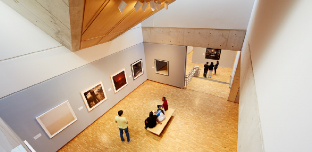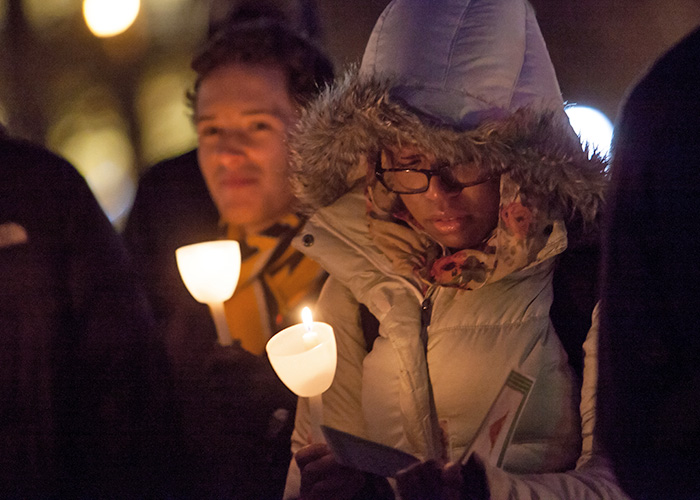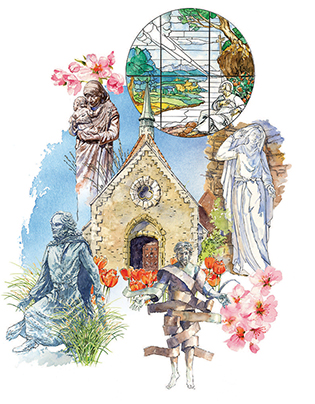
Dear Marquette University Family and Friends,
Welcome to our Sacred Spaces Pilgrimage Tour.
Whether you are using this website to visit 12 of our most notable spiritual sites on campus or simply reading about them, we hope you enjoy being introduced to - or getting reacquainted with - these beautiful spaces of art, history, reflection, prayer and serenity.
With our university located in the heart of urban Milwaukee, it can be easy to get caught up in the noise, energy and excitement of the city and campus life. We are blessed to be gifted with places across campus that give us reason to pause, taking a moment to reflect on the spiritual foundations of Marquette, which include the invitation to pray. These Sacred Spaces beckon us to remember not only our place in the world, on this campus, and in God’s love and care for us, but also our dynamic vocation to love, honor and serve our God and
neighbor.
Dr. Michael Lovell, the 24th and first lay president of Marquette University, developed the Sacred Spaces Pilgrimage. It was his capstone project as a student in the Ignatian Colleagues Program, an 18-month national formation initiative for leaders of the 27 Jesuit universities and colleges in the United States. Having spent time reflecting, praying the Rosary, honoring the Blessed Sacrament through quiet adoration, and participating in small and large group prayer and liturgical celebrations on campus, Dr. Lovell has experienced Marquette’s Sacred Spaces firsthand. He recognized their importance in growing faith, lives of prayer and reflection, and the Catholic identity animated by our Jesuit charism.
Each of the lovely and inspirational spaces described in this website underscores the higher purpose to live our lives with attention and intention. Each space reminds us of our unique call to live lives of meaning through which we can contribute to the greater good of our communities, our Churches and our world.
May you experience the blessings of faith and beauty on our campus and in our lives as you spend time enjoying Marquette’s Sacred Spaces.
Click through the tabs above to discover our remarkable chapels, artwork and sacred spaces on campus. See how the Marquette community lives its Jesuit and Catholic identity every day.
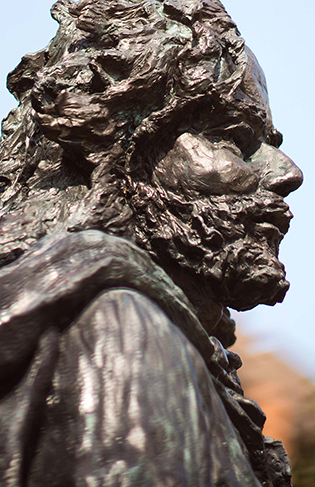
Father (Père) Jacques Marquette
Artist: Ron Knepper
This bronze statue, which honors the 17th-century French Jesuit missionary and explorer for whom Marquette University is named, stands 8 feet, 2 inches tall and weighs between 2,500 and 3,000 pounds. John (Bus Ad ’56) and Mary Madden made a gift of this statue as part of the Magis Campaign, and it was dedicated on Sept. 23, 2005.
Located on Central Mall immediately east of St. Joan of Arc Chapel, the statue depicts a mature Father Marquette, his face weathered by the elements and his cassock beaten with wear. He carries a map — a salute to his mission work along the upper Mississippi River with French fur trader and explorer Louis Joliet — and wears a crucifix at his belt. Father Marquette appears to be stepping away from the water’s edge, a pose that illustrates both his long journey and his evangelizing of Native American tribes.
Tour the Joan of Arc Chapel.
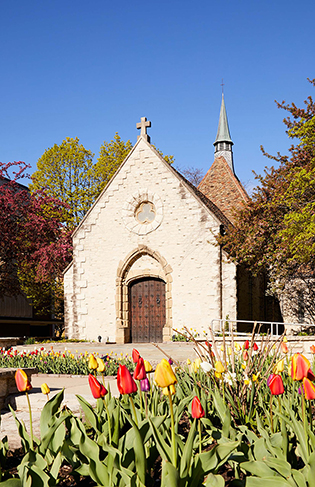
St. Joan of Arc Chapel
Originally known as St. Martin de Seyssuel, the St. Joan of Arc Chapel was constructed in the late 14th or early 15th century in southeastern France near the city of Lyon. After the French Revolution, it gradually became dilapidated. After World War I, a young French architect and archaeologist discovered the ruined chapel and decided to reconstruct it.
In 1926, Mrs. Gertrude Hill Gavin acquired the chapel and had it transferred to her 50-acre estate on Long Island, New York. Mrs. Gavin was so enamored with St. Joan that she renamed the chapel. Joan of Arc (1412–31) was a French heroine of the Hundred Years War, which involved territorial disputes between the kings of England and France. After her capture, she was convicted of heresy and burned at the stake at the age of 19. Posthumously retried and vindicated, Joan was canonized in 1920 and is the patron saint of France. In 1933, Pope Pius XI gave Mrs. Gavin written permission to have Mass said in the building (the letter hangs in the chapel’s nave).
To further honor St. Joan, Mrs. Gavin bought a 13th-century Gothic altar and “Joan of Arc Stone.” Backed by an official French endorsement of authenticity, the stone is believed to be one upon which Joan prayed for success before battle. The stone, reportedly kissed by the lips of the saint, was installed in the base of a wall niche behind the altar. Legend claims that it is always colder to the touch than the stones around it.
After Mrs. Gavin died, her estate ultimately passed into the possession of Mr. and Mrs. Marc B. Rojtman in 1962. The Rojtmans gifted the chapel to Marquette in 1964. They had it dismantled and sent to campus for the university to reconstruct beginning in July 1965. The chapel was dedicated at its new site on May 26, 1966.
Click here for more information about the St. Joan of Arc Chapel
Tour the Grotto of the Blessed Virgin.
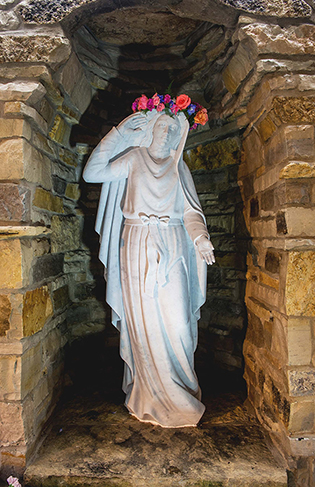
Blessed Virgin Mary Grotto
On December 8, 2017 — the Feast of the Immaculate Conception — Marquette University President Michael R. Lovell announced that the university would construct a grotto dedicated to the Blessed Virgin Mary, providing “a special and sacred place of devotion, inspiration and prayer for Marquette students, faculty, alumni and staff for decades to come.” The generosity of Geri (“Nana”) Fotsch, Kathlyn and Christopher Callen, and Norman Hoffman made this invaluable campus gift possible.
Marian grottos have been a popular expression of devotion to Our Lady all around the world since St. Bernadette Soubirous encountered the Blessed Mother in a natural grotto near Lourdes, France, in 1858. Given Marquette’s Jesuit identity, it is most appropriate to feature a Marian grotto on campus because Mary is recognized as instrumental in the conversion of St. Ignatius, who founded the Society of Jesus (the Jesuit order).
Indeed, the 17th-century Jesuit explorer and university namesake Rev. Jacques Marquette, S.J., wrote the following prayer to venerate the Blessed Virgin:
Hail Daughter of God the Father, hail Mother of God the Son, hail Spouse of God the Holy Ghost, hail Temple of All the Persons of the Trinity, by your holy virginity and your Immaculate Conception, make clean my heart and my song.
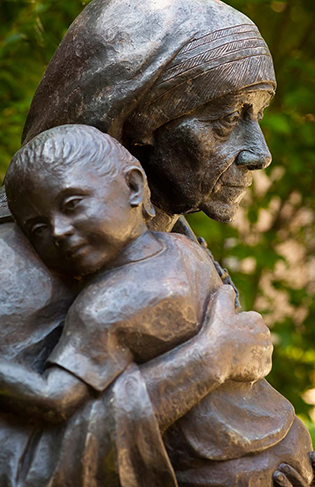
Mother Teresa
"If you can't feed a hundred people, then feed just one." - Mother Teresa
Artist: Gautam Pal
Mother Teresa, recipient of the 1981 Marquette University Père Marquette Discovery Award, was born in 1910 in what is now the capital of the Republic of Macedonia and died in Calcutta, India, in 1997. She labored among the poorest of the poor, first in India and then all over the world. She founded the Missionaries of Charity, a religious congregation of women, and her work with the abandoned, sick and dying was recognized in 1979 when she won the Nobel Peace Prize. By 1996, one year before her death, she was operating 517 missions in more than 100 countries.
Mother Teresa was beatified by Pope John Paul II in 2003. Her loving spirit inspired philanthropy across the world. Pope Francis canonized Mother Teresa as a saint in 2016.
This gift was made possible by members of the Kuttemperoor family, through their friendship with Dr. Prem S. Sharma, professor emeritus and associate dean emeritus, School of Dentistry.
The statue was dedicated on October 6, 2009.
Tour the Chapel of the Holy Family.
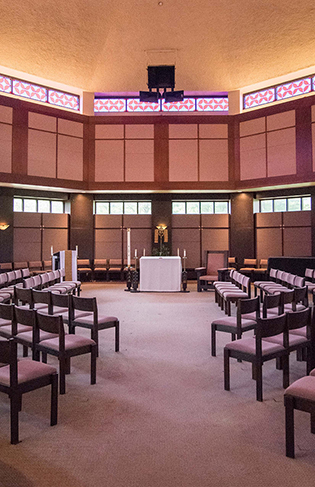
Chapel of the Holy Family
Located in the Alumni Memorial Union, the Chapel of the Holy Family was made possible through the generosity of Dr. Robert and Mrs. Sandy Pavlic. The chapel consists of several components: a large liturgical space (pictured left), Narthex and small Eucharistic Chapel where the Blessed Sacrament is reserved.
The Chapel of the Holy Family was blessed by Bishop Leo J. Brust, auxiliary bishop of the Archdiocese of Milwaukee, on October 6, 1990. The formal blessing does not preclude use by other faiths. In fact, the liturgical space was deliberately constructed to be used by all campus religious groups for worship and prayer. It can seat 130–175 people comfortably, depending on the configuration.
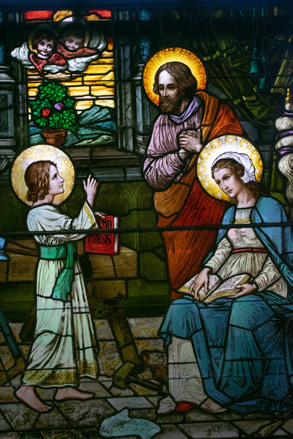
The Narthex
The Narthex (located at the entry of the large liturgical space) features a stained-glass depiction of the Holy Family. Created by the studio of Francis Xavier Zettler of Munich, this window was originally installed in the University Chapel in Johnston Hall, which is the home of the Diederich College of Communication and Marquette’s oldest academic building.
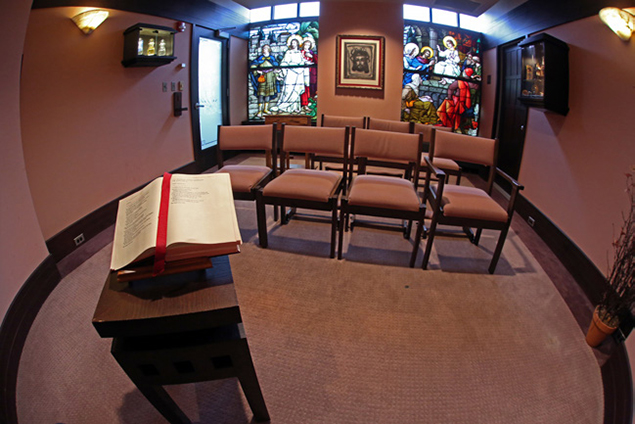
Eucharistic Chapel
The two stained-glass windows in the Eucharistic Chapel were originally located in the University Chapel in Johnston Hall. The windows, which depict the parable of the rich young man (Matt 19:16-30); Mark 10:17-31; Luke 18:18-30), and finding of Jesus in the temple (Luke 2:41-52), were installed in 1993. This room is used exclusively for private prayer and devotion. Adjoining the Eucharistic Chapel is a reconciliation room, which offers the opportunity for anonymous or face-to-face celebration of the Sacrament of Reconciliation.
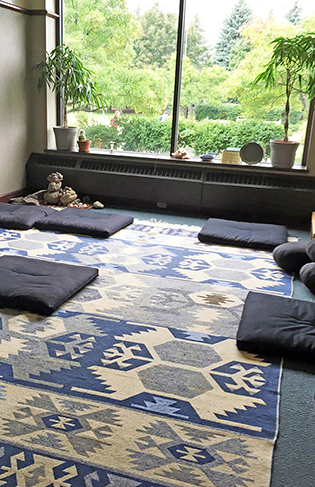
Interfaith Prayer and Meditation Room
Located in room 233 of the Alumni Memorial Union, the Interfaith Prayer and Meditation Room is open daily for individual prayer and meditation. The room is accessible during the regular hours of the Alumni Memorial Union building and may be reserved for groups for one-time use or regular spiritual reflection and ritual.
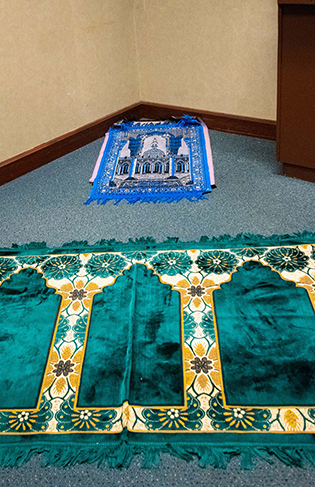
Muslim Prayer Room
Located in room 231 of the Alumni Memorial Union, the Muslim Prayer Room provides a dedicated space for Muslim prayer. Furnished with prayer rugs and prayer resources, this room offers a quiet place for individual prayer or contemplation throughout the day. The room, which features a divider to ensure the comfort of all worshippers, is accessible during the regular hours of the Alumni Memorial Union building.
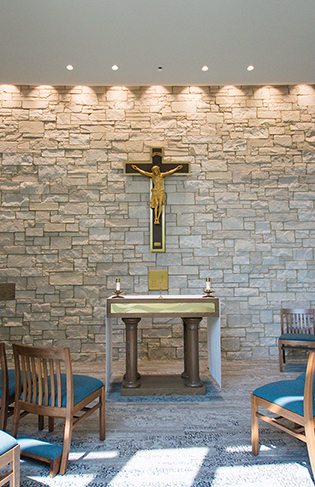
St. Thérèse of Lisieux Chapel
"My God I love you!" - St. Thérèse of Lisieux
Thérèse Martin is a French saint who lived her life for God. This space in The Commons Residence Hall, which was made possible through the generosity of the John Bergstrom Family, is named in honor of the beloved nun known as Saint Thérèse, “The Little Flower.”
Through a transformational experience at age 14, Thérèse focused on God rather than herself, entering the Carmelite convent in Lisieux, France, at age 15. As she wrote in her autobiography, “What matters in life is not great deeds, but great love.” Her unwavering love of God led her to have a childlike, simple approach to treating everyone with love.
Thérèse’s simplicity is like that of flowers, which she admired. She regarded herself as the “little flower of Jesus,” her own life blossoming for His glory. A rose symbolizes both her physical and eternal life. As stated in her autobiography, “My mission — to make God loved — will begin after my death. I will spend my heaven doing good on earth. I will let fall a shower of roses.”
Thérèse’s spirituality has inspired millions, who, since her death in 1897 from tuberculosis, have sought her intercession and inexplicably received flowers. Pope Pius XI canonized her as a saint in 1925. In 1997, Pope John Paul II declared the saint a Doctor of the Church, acknowledging her worldwide renown as one of the greatest modern-day saints.
Reflecting Thérèse’s life of simple daily prayer, this chapel facilitates a late afternoon Rosary on Tuesday through Friday.
Tour the Christ Arisen Statue

Christ Arisen
Artist: Norman Christianson
Located west of the Varsity Theatre, Christ Arisen features Christ with his arms down and extended in an open, loving gesture. The statue was a gift to Marquette University from Dr. and Mrs. Leslie Webber and Family, in loving memory of their son and brother, Richard (1962–1983).
Richard Webber died during his senior year while racing with the Marquette sailing team on Lake Michigan. The gift included the statue, dedicated on October 21, 2002; stained-glass rotunda windows in the Chapel of the Holy Family in the Alumni Memorial Union; and safety equipment for the sailing team.
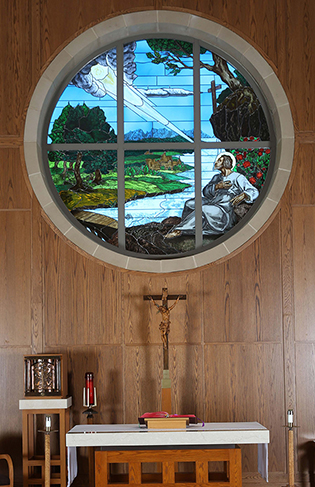
Donald J. Schneider Chapel
Thanks to the generosity of Donald and Patricia Schneider, the Donald J. Schneider Chapel is the largest of three chapels in the Dr. E.J. O’Brien Jesuit Residence. The Jesuits gather here daily to celebrate Mass and appreciate the beauty of nature through the large windows in the chapel.
The brilliant, specially designed stained-glass window is particularly notable. Made possible through a gift from the Bernice Greiveldinger Charitable Trust, the circular window is the work of Racine native John D. Van Koningsveld. It is his interpretation of a 17th-century etching by Flemish artist Peter Paul Rubens. The image depicts the moment when Saint Ignatius of Loyola (founder of the Society of Jesus) received from God the most profound enlightenment while praying by the river Cardoner near the village of Manresa, Spain, in 1522. Ignatius later described how his enlightenment was “so strong that all things seemed new to him.… [Indeed] the many things he had learned throughout his 62 years, taken together… would not amount to what he had received on that single occasion.” His experience undergirds the Christian vision of God and human life set forth in the Spiritual Exercises, a manual for guiding retreatants over a period of 30 days, and resulted in the foresight that led to the founding of Jesuit colleges and universities around the world.
Tour the Madonna Della Strada Chapel.
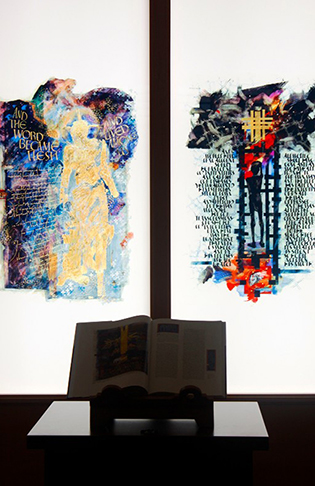
Madonna Della Strada Chapel
The Madonna Della Strada Chapel, named in honor of the first Jesuit church in Rome, offers Marquette community members a quiet, intimate space inside Zilber Hall, one of the university’s most active buildings.
The chapel features four glass panels imprinted with illustrations from The Saint John’s Bible (see below). Colorful depictions of the Creation story, the Word Made Flesh, the Suffering Servant, and the Resurrected Jesus appearing to Mary Magdalene illuminate the chapel. Each one stands nearly six feet tall and serves as the chapel’s main visual draw.
This sacred space is available to all members of the Marquette community for prayer and meditation.
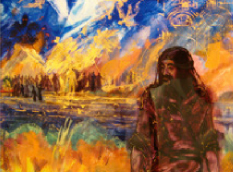
The Saint John's Bible
In 1998, Saint John’s Abbey and University commissioned renowned calligrapher Donald Jackson, senior scribe in Queen Elizabeth II’s Crown Office, to produce the first handwritten, hand-illuminated Bible since the advent of moveable type in the 15th century. Jackson designed a custom script for the work and assembled a team of artists and scribes from around the world who used ancient techniques and materials — goose quills, hand-ground pigments, egg yolks, and 24-karat gold leaf. On being presented with a copy in 2008, Pope Benedict XVI exclaimed, “This is a work for eternity.” The Saint John’s Bible includes 160 illuminations, reflecting a contemporary approach to biblical interpretation and incorporating imagery from both Eastern and Western religious traditions. The volumes are permanently displayed in the Prucha Archives Reading Room on the third floor of the John P. Raynor, S.J., Memorial Libraries.
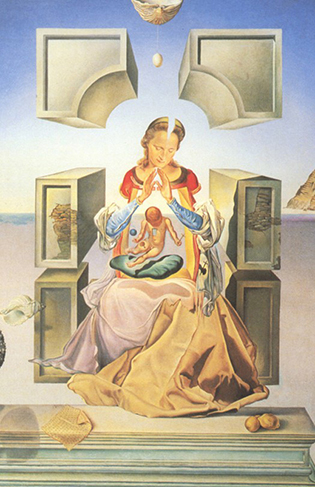
Madonna of Port Lligat
Artist: Salvador Dalí
Created: 1949
Medium: Oil on canvas
Dimensions: 19.5 x 15.0625 in.
Gift of Mr. and Mrs. Ira Haupt
Collection of The Haggerty Museum of Art
The Madonna of Port Lligat is the name of two paintings by Salvador Dalí. The first was created in 1949 and is housed in the Haggerty Museum of Art at Marquette. Dalí submitted it to Pope Pius XII for approval, which was granted. Dalí created a second, larger painting in 1950 using the same title and same themes, with various poses and details changed. The 1950 Madonna is exhibited at the Fukuoka Art Museum in Japan.
The paintings depict a seated Madonna (Dalí’s wife, Gala, served as the model) with the infant Christ on her lap. Both figures have rectangular holes cut into their torsos, suggestive of their transcendent status. They are posed in a landscape featuring the coast of Port Lligat, Catalonia, in the background, with surrealist details such as nails, fish, seashells and an egg.
Haggerty Museum of Art
